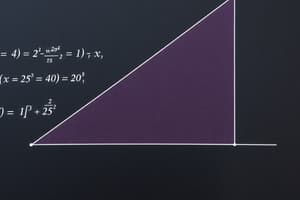Podcast
Questions and Answers
The graph of a quadratic function is a(n) _______.
The graph of a quadratic function is a(n) _______.
parabola
The function $f(x) = x^2$ is called the:
The function $f(x) = x^2$ is called the:
- Quadratic Parent Function (correct)
- Quadratic Regression
- Quadratic Child Function
- Quadratic Transform Function
To model the height of an object launched into the air $t$ seconds after it is launched, you can use the _______.
To model the height of an object launched into the air $t$ seconds after it is launched, you can use the _______.
vertical motion model
The _______ is $f(x) = ax^2 + bx + c.
The _______ is $f(x) = ax^2 + bx + c.
A(n) _______ is a method used to find a quadratic function that best fits a data set.
A(n) _______ is a method used to find a quadratic function that best fits a data set.
If the 'a' value in a quadratic function $f(x) = ax^2 + bx + c$ is negative, the parabola opens upwards.
If the 'a' value in a quadratic function $f(x) = ax^2 + bx + c$ is negative, the parabola opens upwards.
What is the vertex form of a quadratic function?
What is the vertex form of a quadratic function?
In the vertex form $f(x) = a(x - h)^2 + k$, what does 'h' represent?
In the vertex form $f(x) = a(x - h)^2 + k$, what does 'h' represent?
What does the 'c' value represent in the standard form of a quadratic equation, $f(x) = ax^2 + bx + c$?
What does the 'c' value represent in the standard form of a quadratic equation, $f(x) = ax^2 + bx + c$?
The axis of symmetry for a quadratic function in standard form is always the y-axis.
The axis of symmetry for a quadratic function in standard form is always the y-axis.
How do you determine the y-intercept of a quadratic function in standard form?
How do you determine the y-intercept of a quadratic function in standard form?
Given a quadratic function in vertex form, $f(x) = a(x - h)^2 + k$, what is the vertex of the parabola?
Given a quadratic function in vertex form, $f(x) = a(x - h)^2 + k$, what is the vertex of the parabola?
If a parabola opens downwards, it has a minimum value.
If a parabola opens downwards, it has a minimum value.
What is the formula for finding the axis of symmetry for a quadratic function in the standard form $f(x) = ax^2 + bx + c$?
What is the formula for finding the axis of symmetry for a quadratic function in the standard form $f(x) = ax^2 + bx + c$?
Match each quadratic function form with its defining characteristic:
Match each quadratic function form with its defining characteristic:
What is the first step in determining whether a table shows a linear, quadratic, or exponential function?
What is the first step in determining whether a table shows a linear, quadratic, or exponential function?
If the first differences in a table of values are constant, the function is quadratic.
If the first differences in a table of values are constant, the function is quadratic.
What type of function is represented if the ratios between consecutive y-values are constant?
What type of function is represented if the ratios between consecutive y-values are constant?
Alberto launches an emergency flare at an initial velocity of 64 ft/s from an initial height of 6 ft. Which of the following equations can be used to model the situation?
Alberto launches an emergency flare at an initial velocity of 64 ft/s from an initial height of 6 ft. Which of the following equations can be used to model the situation?
The _______ is $x = -b/2a$.
The _______ is $x = -b/2a$.
Flashcards
Parabola
Parabola
The graph of a quadratic function.
Quadratic Parent Function
Quadratic Parent Function
A basic quadratic function, f(x) = x².
Quadratic Regression
Quadratic Regression
A statistical method to find a quadratic function that best fits a data set.
Standard Form of a Quadratic Function
Standard Form of a Quadratic Function
Signup and view all the flashcards
Vertex Form of a Quadratic Function
Vertex Form of a Quadratic Function
Signup and view all the flashcards
Quadratic Functions in Vertex Form
Quadratic Functions in Vertex Form
Signup and view all the flashcards
Quadratic Functions in Standard Form
Quadratic Functions in Standard Form
Signup and view all the flashcards
Modeling With Quadratic Functions
Modeling With Quadratic Functions
Signup and view all the flashcards
Linear, Exponential, and Quadratic Models
Linear, Exponential, and Quadratic Models
Signup and view all the flashcards
Study Notes
Key Features of Quadratic Functions
- The graph of f(x) = ax² is a parabola with vertex (0, 0) and axis of symmetry x = 0.
- When a > 0, the parabola opens upward and the function has a minimum at the vertex.
- When a < 0, the parabola opens downward and the function has a maximum at the vertex.
- The graph of g(x) = -0.2x² opens downward and is wider than the graph of f(x) = x².
- For both graphs, the axis of symmetry is x = 0 and the vertex is (0, 0).
Modeling With Quadratic Functions
- Quadratic functions can model situations.
- A vertical motion model is a quadratic function.
- Alberto launches an emergency flare at an initial velocity of 64 ft/s from an initial height of 6 ft.
- Rescue team wants the flare must reach a height of 100 ft to be seen.
- 64 is substituted for v₀ and 6 for h₀ in the vertical motion model.
- The vertical motion equation is h(t) = -16t² + 64t + 6.
- The vertex (t, h(t)) can be found by finding t = -b/2a = -64/(2(-16)) = 2.
- The h(2) = -16(2)² + 64(2) + 6 = 70.
- Therefore the vertex is (2, 70).
- The flare will reach a maximum height of 70 ft, so Alberto’s launch is not successful.
Linear, Exponential, and Quadratic Models
- To determine which function best models a data set, analyze the differences and ratios between consecutive y-values when the differences in consecutive x-values are constant.
- Since the ratio between the y-values is constant, the function is exponential.
Quadratic Functions in Vertex Form
- The vertex form of a quadratic function is f(x) = a(x - h)² + k.
- The vertex of the graph is at (h, k) and the axis of symmetry is x = h.
- The function f(x) = (x + 1)² - 1 has a vertex at (-1, -1) and the axis of symmetry is x = -1.
Quadratic Functions in Standard Form
- The standard form of a quadratic function is f(x) = ax² + bx + c, where a ≠ 0.
- The y-intercept is c and the axis of symmetry, which is also the x-coordinate of the vertex, is x = -b/2a.
- For the function f(x) = 3x² - 6x + 2, the y-intercept is 2.
- The axis of symmetry can be found by calculating x = -b / 2a = -(-6) / 2(3) = 1.
- The y-coordinate of the vertex: f(1) = 3(1)² - 6(1) + 2 = -1.
- Plot the vertex (1, -1), identify the axis of symmetry and plot the y-intercept (0, 2).
- Reflect that point across the axis of symmetry.
Studying That Suits You
Use AI to generate personalized quizzes and flashcards to suit your learning preferences.




